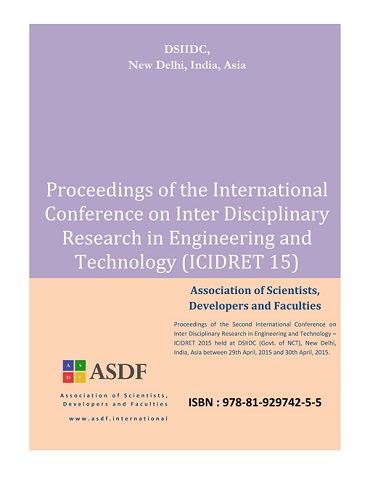- Publication Meta:Value
- Short Title:ICIDRET 2015
- Publisher:ASDF, India
- ISBN 13:978-81-929742-5-5
- ISBN 10:81-929742-5-1
- Language:English
- Type:Hard Bound - Printed Book
- Copyrights:ICIDRET Organizers/ icidret.org
- Editor-in-Chief:Kokula Krishna Hari K
- Conference Dates:29 - 30, April 2015
- Venue Country:New Delhi, India
- Submitted Papers:525
- Acceptance Rate:7.62%
- Website:www.icidret.in
Welcome to ASDF Electronic Digital Library!
ICIDRET 2015
ICIDRET 2015
International Conference on Inter Disciplinary Research in Engineering and Technology 2015
Paper 033
Studies On The Effect Of Different Nose Radius In Micro Turning Of Stainless Steel 316l
R Binoy1, A Gopikrishnan2, M Kanthababu3
1,2,3Anna University
Abstract
This paper presents the effect of different tool nose radii of 0.03, 0.1, 0.2 and 0.4 mm on tool wear, surface roughness, chip morphology, signals acquired from different sensor such as Acoustic Emission (AE), accelerometer and cutting force dynamometer in micro turning of stainless steel (SS 316L). Experiments have been carried out with coated tungsten carbide insert up to 60 minutes. Measurements and the signals are analysed for every 1st minute and 10th minute. It is observed that tool wear and chip width is found to be increasing, while Ra is found to be following non-uniform trend with increase in the nose radius. From the AE and vibration signal analysis, it is found that the dominant frequency of the signals increases with increase in the nose radius. Among the cutting forces, the tangential force (Fy) is found to be more sensitive to the tool wear status compared to that of the thrust force (Fx) and feed force (Fz). This study will be useful for the manufacturers to monitor the condition of the tool online while micro turning of SS 316L.
Keywords
Author's Profile
Author profile can be generated and linked through our partners World Book of Researchers. To include your profile online Click Here. After it is approved, please email to edlib @ asdf.res.in to create a link with all the papers.
e-AID
ICIDRET.2015.033
Cite this Article as Follows
Binoy R, Gopikrishnan A, Kanthababu M. Studies On The Effect Of Different Nose Radius In Micro Turning Of Stainless Steel 316l. International Conference on Inter Disciplinary Research in Engineering and Technology 2015. Vol. 1. Chennai: Association of Scientists, Developers and Faculties, 2015. 104-208. Print.
© 2010 - by EDLIB .
All Rights Reserved.

